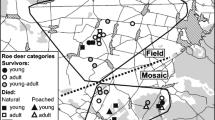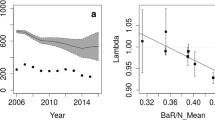Abstract
The dispersal, population dynamics, and ecological features of the European roe deer at the northern limit of species distribution and also their visits, wintering, and breeding outside the range boundary are discussed. A significant increase in the abundance of roe deer in the northern part of the range and their largescale expansion beyond the historical distribution limit have taken place during the past decade. However, their spread in Karelia and Arkhangelsk oblast is strictly limited, depending primarily on snow depth and duration. Hunting the roe deer as a game species in the region is possible only in the south of Pskov oblast, where habitat conditions are most favorable for it.
Similar content being viewed by others
References
Geptner, V.G., The European roe deer Capreolus capreolus Linnaeus, 1758: Geographic distribution, in Mlekopitayushchie Sovetskogo Soyuza (Mammals of the Soviet Union), vol. 1, Moscow: Vysshaya Shkola, 1961, pp. 182–199.
Rusakov, O.S., Distribution, resources, and management of ungulates in northwestern regions of the European Soviet Union, in Voprosy povysheniya produktivnosti okhotnich’ikh ugodii (Problems in Improving the Productivity of Hunting Areas), Moscow, 1969, pp. 149–169.
Rusakov, O.S., Current state of resources, ecology, and management of ungulates in the northwest of the Soviet Union, in Kopytnye Severo-Zapada SSSR (Ungulates in the Northwest of the Soviet Union), Leningrad: Nauka, 1979, pp. 63–293.
Timofeeva, E.K., Kosulya (The Roe Deer), Leningrad: Leningr. Gos. Univ., 1985.
Inostrantsev, A.A., Doistoricheskii chelovek kamennogo veka poberezh’ya Ladozhskogo ozera (The Prehistoric Stone Age Man on the Shores of Lake Ladoga), St. Petersburg, 1882.
Vereshchagin, N.K., Ungulates in northwestern Russia during the Quaternary Period, in Kopytnye Severo- Zapada SSSR (Ungulates in the Northwest of the Soviet Union), Leningrad: Nauka, 1979, pp. 5–62.
Danilkin, A.A., Olen’i (The Cervidae), Moscow: GEOS, 1999.
Siivonen, L. Suomen nisäkkäät: 2, Keuruu: Otava, 1972.
Siivonen, L. and Sulkava, S., Pohjolan nisäkkäät, Helsinki, 1994, pp. 191–193.
Helle, P., Metsakauris, in Riistan jaljille, Helsinki, 1996, pp. 100–102.
Kankaanpaa, S., Metsakauris-tiheydet riistanhoitoyndistyksissa, Metsastaja, 1999, vol. 1, pp. 18–21.
Luoma, M., Metsakauriin ravinnonkaytto ja vahingot maa- ja metsataloudelle (Summary: Food selection of roe deer and damage caused to agriculture and forestry, Suomen Riista, 2004, vol. 50, pp. 76–83.
Timofeeva, E.K., Essays on the ecology of mammals: Even-toed ungulates, in Zveri Leningradskoi oblasti (Mammals of Leningrad Oblast), Leningrad: Leningr. Gos. Univ., 1970, pp. 270–322.
Kjellander, P., Hewison, A.J.M., Liberg, O., et al., Experimental evidence for density-dependence of home-range size in roe deer (Capreolus L.): A comparison of two long-term studies, Oecologia, 2004, vol. 139, pp. 478–485.
Wikman, M., Riistakannat riistaseurantojen tulokset, Helsinki, 2009.
Kirikov, S.V., Izmeneniya zhivotnogo mira v prirodnykh zonakh SSSR (XIII–XIX vv.). Lesnaya zona i lesotundra (Changes of the Fauna in Natural Zones of the Soviet Union in the 13th to 19th Centuries: The Forest and Forest–Tundra Zones), Moscow, 1960.
Ozeretskovskii, N.Ya., Puteshestviya po ozeram Ladozhskomu i Onezhskomu (1792 g.) (Journeys on Lakes Ladoga and Onega in 1792), Petrozavodsk: Kareliya, 1989.
Kessler, K.F., Materialy dlya poznaniya Onezhskogo ozera i Obonezhskogo kraya preimushchestvenno v zoologicheskom otnoshenii. (Pril. k Tr. 1-go s”ezda rus. estestvoispytatelei) (Materials for the Study of Lake Onega and the Onega Region, Mainly from the Zoological Aspect: Supplement to Proceedings of the 1st Congress of Russian Naturalists), St. Petersburg, 1868.
Polyakov, I.S., Soobshcheniya o faune Olonetskoi gubernii (Reports on the Fauna of Olonets Province), Tr. S.-Peterb. O-va Estestvoisp., 1873, vol. 4.
Gromov, I.M., Gureev, A.A., Novikov, G.A, et al., Mlekopitayushchie fauny SSSR (Mammals in the Fauna of the Soviet Union), part 2, Leningrad: Akad. Nauk SSSR, 1963.
Kutepov, N., Tsarskaya i imperatorskaya okhota na Rusi (The Royal and Imperial Hunt in Russia), St. Petersburg, 1900, vol. 4.
Kutepov, N., Tsarskaya i imperatorskaya okhota na Rusi. Konets 18 i 19 vek (The Royal and Imperial Hunt in Russia: The Late 18th and 19th Centuries), St. Petersburg, 1911, vol. 5.
Baleiöis, R., Bluzma, P., and Balčiauskas, L., Lietuvos kanopiniai ûvėrys, Vilnius: Akstis, 2003.
Lavrov, N.P., Geographic distribution, biology, and economic significance of roe deer in the Soviet Union, Tr. po Lesnomu Opytnomu Delu Tsentr. Lesn. Opytn. Stantsii, 1929, no. 6, pp. 49–82.
Mirutenko, V.S., The roe deer (Capreolus capreolus L., 1758), in Sostoyanie resursov okhotnich’ikh zhivotnykh v Rossiiskoi Federatsii v 2000–2003 gg.: Informatsionnoanaliticheskie mat-ly (The State of Game Animal Resources in the Russian Federation, 2000–2003: Analytical Information), Moscow: Tsentrokhotkontrol’, 2004, pp. 33–38.
Mirutenko, V.S., Roe deer (Capreolus capreolus L., 1758, C. pygargus Pall., 1771), in Sostoyanie resursov okhotnich’ikh zhivotnykh v Rossiiskoi Federatsii v 2003–2007 gg.: Informatsionno-analiticheskie mat-ly (The State of Game Animal Resources in the Russian Federation, 2003–2007: Analytical Information), Moscow: Tsentrokhotkontrol’, 2007, pp. 28–32.
Komissarov, M.A., Roe deer, in Sostoyanie okhotnich’ikh resursov v 2008–2010 gg.: Informatsionno-analiticheskie mat-ly (The State of Game Animal Resources in the Russian Federation, 2008–2010: Analytical Information), Moscow: Fizicheskaya Kul’tura, 2011.
Burbaite, L. and Csanyi, S., Roe deer population and harvest changes in Europe, Est. J. Ecol., 2009, vol. 58, pp. 169–180.
Danilov, P.I., Occurrence of the wild boar and roe deer in Karelia, in Voprosy ekologii zhivotnykh (Problems in Animal Ecology), Petrozavodsk: Karel. Fil. Akad. Nauk SSSR, 1974, pp. 158–160.
Sokolov, I.I., Ungulates, Fauna SSSR. Mlekopitayushchie The Fauna of the Soviet Union: Mammals), vol. 1, no. 3, Moscow: Akad. Nauk SSSR, 1959.
Danilov, P.I., Novye vidy mlekopitayushchikh na Evropeiskom Severe Rossii (New Mammal Species in the North of European Russia), Petrozavodsk: Karel. Nauch. Tsentr. Ross. Akad. Nauk, 2009.
Tyan-Shanskii, O.I., Zveri Murmanskoi oblasti (Mammals of Murmansk Oblast), Murmansk: Murmansk. Knizhn. Izd., 1982.
Makarova, O.A., Distribution of ungulates in Murmansk oblast in the early 21st century, in Povedenie, ekologiya i evolyutsiya zhivotnykh (Animal Behavior, Ecology, and Evolution), vol. 2, Ryazan: NP Golos Gubernii, 2011, pp. 185–195.
Siivonen, L., Mlekopitayushchie Severnoi Evropy (Mammals of Northern Europe), Moscow: Lesnaya Promyshlennost’, 1979.
Gosudarstvennyi doklad o sostoyanii okruzhayushchei sredy Respubliki Kareliya v 2014 godu (State Report on the State of the Environment in the Republic of Karelia in the Year 2014), Petrozavodsk: Verso, 2015.
Bergstrom, R. and Bergqvist, G., Frequencies and patterns of browsing by large herbivores on conifer seedlings, Scand. J. For. Res., 1997, vol. 12, pp. 288–294.
Bergquist, J. and Orlander, G., Browsing damage by roe deer on Norway spruce seedlings planted on clearcuts of different ages: 1. Effect of slash, vegetation development and roe deer density, For. Ecol. Manag., 1998, vol. 105, pp. 283–293.
Lyly, M., Klemola, T., Koivisto, E., et al., Varying impacts of cervid, hare and vole browsing on growth and survival of boreal tree seedlings, Oecologia, 2014, vol. 174, no. 1, pp. 271–281. doi 10.1007/s00442-013-2761-1
Pulliainen, E., Winter diet of Felis lynx L. in SE Finland as compared with nutrition of other northern lynxes, Z. Saugetierkd., 1981, vol. 46, pp. 249–259.
Birkeland, K.H. and Myrberget, S., The diet of the lynx, Lynx lynx, in Norway, Fauna Norv. Ser. A, 1980, no. 1, pp. 24–28.
Jarnemo, A., Neonatal mortality in roe deer, Ph.D. Thesis, Uppsala: Swedish University of Agricultural Sciences (SLU), 2004.
Odden, J.J., Linnell, D.C., and Andersen, R., Diet of Eurasian lynx, Lynx lynx, in the boreal forest of southeastern Norway: The relative importance of livestock and hares at low roe deer density, Eur. J. Wildl. Res., 2006, vol. 52, pp. 237–244.
Nordström, J., Temporal and spatial variation in predation on roe deer fawns, Ph.D. Thesis, Uppsala: Swedish University of Agricultural Sciences (SLU), 2010.
Andrén, H. and Liberg, O., Large impact of Eurasian lynx predation on roe deer population dynamics, PLOS ONE, 2015, vol. 10, no. 3, e0120570. doi 10.1371/journal. pone.0120570
Lindström, E.R., Andrén, H., Angelstam, P., et al., Disease reveals the predator: Sarcoptic mange, red fox predation, and prey populations, Ecology, 1994, vol. 75, pp. 1042–1049.
Kjellander, P. and Nordstrom, J., Cyclic voles, prey switching in red fox, and roe deer dynamics: A test of the alternative prey hypothesis, Oikos, 2003, vol. 101, pp. 338–344.
Jarnemo, A. and Liberg, O., Red fox removal and roe deer fawn survival: A 14-year study, J. Wildl. Manag., 2005, vol. 69, pp. 1090–1098.
Author information
Authors and Affiliations
Corresponding author
Additional information
Original Russian Text © P.I. Danilov, D.V. Panchenko, K.F. Tirronen, 2017, published in Ekologiya, 2017, No. 5, pp. 377–384.
Rights and permissions
About this article
Cite this article
Danilov, P.I., Panchenko, D.V. & Tirronen, K.F. The European roe deer (Capreolus capreolus L.) at the northern boundary of its range in Eastern Fennoscandia. Russ J Ecol 48, 459–465 (2017). https://doi.org/10.1134/S1067413617050046
Received:
Published:
Issue Date:
DOI: https://doi.org/10.1134/S1067413617050046




